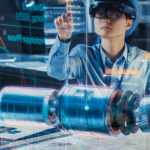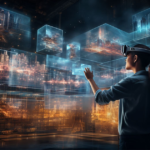Virtual Reality (VR) is transforming how we interact with digital environments, making experiences more immersive and engaging than ever before. From gaming and healthcare to education and business, VR is reshaping industries and creating new possibilities. This article explores the evolution, applications, benefits, and challenges of VR, as well as its potential future impact on technology and society.
Understanding Virtual Reality
1. What is Virtual Reality?
Virtual Reality (VR) is a computer-generated simulation of an interactive, immersive environment that can be experienced using VR headsets, motion controllers, and other sensory devices. Unlike traditional screens, VR places users inside a 3D digital world, enabling them to interact with objects and environments in real time.
2. The Evolution of Virtual Reality
- 1960s-1980s: Early VR systems like the Sensorama and NASA’s ViewLab were developed for research and training.
- 1990s: VR gained popularity in gaming and military training but faced technological limitations.
- 2000s-Present: Advancements in computing power, graphics, and motion tracking have made VR more accessible and realistic.
- Future: Continuous improvements in hardware, AI integration, and connectivity are expected to expand VR’s capabilities.
Applications of Virtual Reality
1. Gaming and Entertainment
VR gaming provides players with an immersive experience where they can interact with virtual worlds as if they were real. Popular VR gaming platforms include:
- Oculus Rift & Quest
- PlayStation VR
- HTC Vive
- Valve Index
Apart from gaming, VR is also transforming:
- Cinematic experiences with 360-degree films.
- Virtual concerts and live events where users can attend from anywhere in the world.
2. Healthcare and Medicine

VR is making significant contributions to medical training, therapy, and patient care:
- Surgical Simulations – Allows medical students and professionals to practice complex procedures safely.
- Pain Management – VR distraction therapy helps patients cope with chronic pain and anxiety.
- Physical Rehabilitation – VR-based exercises aid in recovery from strokes and injuries.
3. Education and Training
VR enhances learning by creating interactive simulations, making complex subjects more understandable.
- Virtual Classrooms – Platforms like Engage VR and AltspaceVR allow students to learn in a 3D environment.
- Historical Reconstructions – Students can explore ancient civilizations or space missions.
- Professional Training – Pilots, astronauts, and military personnel use VR for realistic training simulations.
4. Business and Remote Work
With the rise of remote work, VR is revolutionizing business operations:
- Virtual Meetings and Conferences – Platforms like Meta’s Horizon Workrooms provide immersive collaboration spaces.
- Product Design and Prototyping – Architects and engineers use VR to create and test designs before production.
- Retail and Virtual Shopping – Customers can explore stores and try products virtually before purchasing.
5. Real Estate and Architecture
VR allows architects and buyers to explore properties before construction or purchase.
- Virtual Property Tours – Prospective buyers can tour homes remotely.
- Architectural Visualization – Designers can present 3D models of buildings for better planning.
6. Military and Defense
VR is extensively used in military training for:
- Combat Simulations – Soldiers can engage in lifelike training without real-world risks.
- Mission Planning – VR helps strategize and test various operational scenarios.
Advantages of Virtual Reality
1. Enhanced Learning and Training
VR provides hands-on experience, improving knowledge retention and skill development.
2. Increased Engagement and Interaction
Users actively participate in virtual environments, making experiences more engaging than traditional methods.
3. Cost and Time Efficiency
Businesses and educational institutions save resources by using VR for training, product testing, and meetings.
4. Remote Accessibility
VR enables people to work, learn, and socialize from anywhere in the world, eliminating geographical barriers.
5. Safe Simulation of Risky Situations
Medical professionals, military personnel, and engineers can practice critical tasks without real-world consequences.
Challenges and Limitations of VR
1. High Cost of VR Equipment

While VR technology is advancing, high-quality headsets and accessories remain expensive for many consumers and businesses.
2. Motion Sickness and Discomfort
Some users experience nausea and dizziness due to VR’s immersive nature and motion tracking.
3. Technical Limitations
- Hardware Limitations – Processing power and battery life can restrict VR experiences.
- Connectivity Issues – High-speed internet is required for seamless multiplayer and online VR experiences.
4. Privacy and Data Security Concerns
As VR collects large amounts of user data, concerns over privacy, hacking, and data misuse are increasing.
5. Social Isolation
Extended VR usage can lead to reduced physical interactions, affecting mental and emotional well-being.
The Future of Virtual Reality
1. Advancements in VR Hardware
Future VR devices will feature:
- Higher resolution displays for more realistic visuals.
- Lighter and more comfortable headsets for extended use.
- Haptic feedback suits and gloves for a more immersive experience.
2. Integration with Artificial Intelligence (AI)
AI-powered VR will enhance interactions, enabling more realistic virtual characters and environments.
3. Expansion into the Metaverse
The concept of the Metaverse, a fully immersive digital world, is gaining traction, with companies like Meta (Facebook) leading the way.
4. More Affordable and Accessible VR
As technology advances, VR devices will become more affordable, making them accessible to a wider audience.
5. VR in Social Media and Communication
Social platforms are integrating VR to create immersive social experiences where users can interact in 3D environments.
Also Read: What Is The Future Of Blockchain In Healthcare?
Conclusion
Virtual Reality is revolutionizing the future of technology by transforming industries, enhancing learning, and improving interactions. While challenges remain, continued advancements in VR hardware, AI integration, and accessibility will further expand its applications. As we move towards a more immersive digital era, VR will play a significant role in shaping how we work, learn, and entertain ourselves.
FAQs
1. What is the main purpose of Virtual Reality?
The main purpose of VR is to create immersive digital environments where users can interact with virtual objects and experiences.
2. Is VR only used for gaming?
No, VR is used in various industries, including education, healthcare, business, real estate, and military training.
3. How expensive is VR technology?
VR headsets range from affordable options like Google Cardboard ($10-$20) to high-end systems like the HTC Vive Pro ($800+). Prices are expected to decrease as technology advances.
4. Can Virtual Reality be harmful?
Extended VR use can cause motion sickness, eye strain, and social isolation. Moderation and proper usage guidelines can minimize risks.
5. What is the future of VR?
The future of VR includes AI integration, enhanced realism, improved affordability, and expansion into social communication and the Metaverse.





